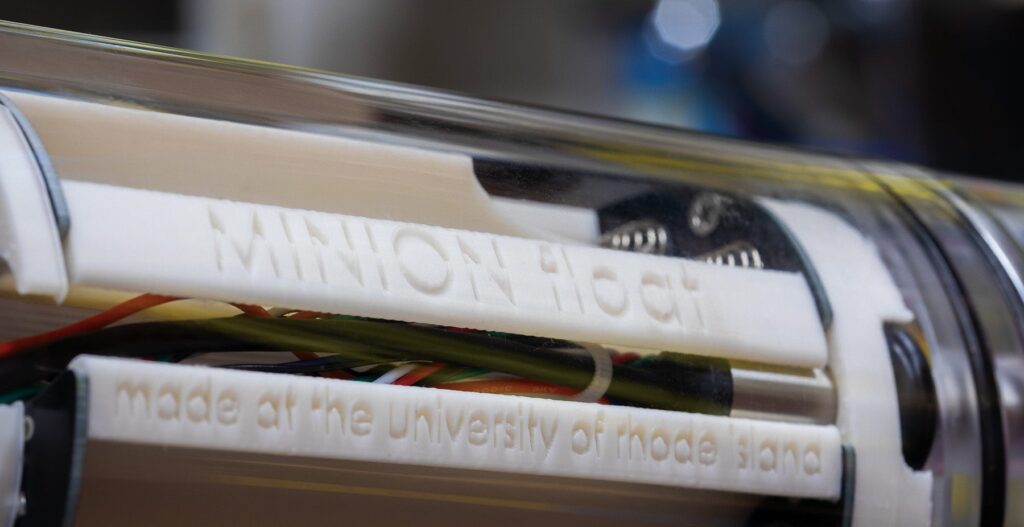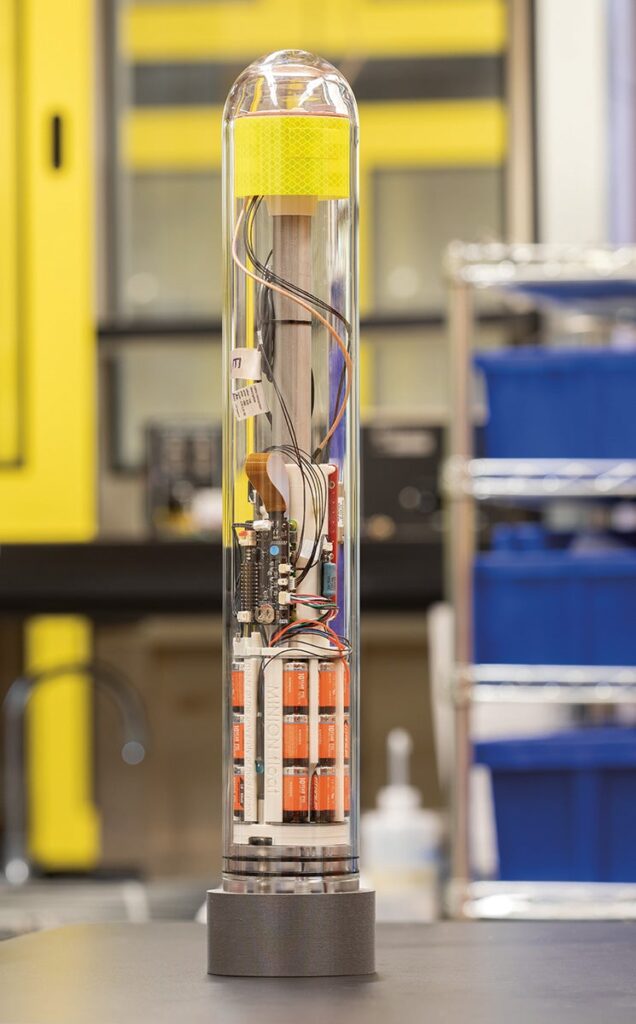How do you most accurately quantify organic ocean carbon to create better models that predict future carbon uptake by the ocean, a key climate change data point? You invent an autonomous floating robot that can measure sinking particulate carbon flux, at various depths. And, you make the technology low cost and open-source so it can be easily replicated and deployed around the globe.
Thanks to a 2021 National Science Foundation (NSF) CAREER award, Melissa Omand, associate professor of oceanography, and her team have done just that. Her lab group studies the physical movement of organic carbon in the ocean and specializes in in-situ imaging and optical proxies from autonomous platforms.

A previous NSF EAGER (EArly-Concept Grants for Exploratory Research) award—Particle-specific DNA sequencing to directly observe ecological mechanisms of the biological pump — served as the seed opportunity for Omand’s CAREER award concept.
“The EAGER project was the first time I put a camera under a sediment trap to intercept sinking particles and see in high resolution what arrived and when, rather than just taking bulk carbon measurements at the end,” she explains. “We were trying to link the surface community to its role in carbon flux, proving we could take that concept and design a more sophisticated autonomous platform that would freely drift.”

The goal of the CAREER project was to enable direct measurements in many locations and depths at once. Traditionally, researchers looking into carbon flux would observe chlorophyll or variations in surface temperature from satellite images or from a few discrete samples from research ships.
“That resulted in a huge variability,” Omand says. “It’s a very complex mosaic of ecosystems and different physical environments, and we know these smaller micro-environments can have a big impact on carbon fluxes in the ocean. So, my challenge was to develop a tool that could take measurements persistently enough and with enough coverage that we capture not a single moment in time, as sampling from a research ship would do, but many places in time sufficiently to resolve this variability.”
“My challenge was to develop a tool that could take measurements persistently enough and with enough coverage that we capture not a single moment in time.”Associate Professor, Melissa Omand
Omand’s robot passively floats with the water column, providing an opportunity to see changes in the local physical environment for organisms living in the water. The technology measures temperature, pressure, and oxygen changes in the water and takes photos of particulate organic carbon. The two – primary data points the team is looking for are the rate of flux of sinking carbon and how rapidly microbial communities take up carbon at various depths.

“Our ability to mitigate and plan for how to confront climate change in the future is only possible to the extent that we can understand, observe, and model those changes,” Omand says. “And having technology like mine that can capture the rich variability of these dynamics in the ocean is essential to be able to build the predictions we need.”
Omand reports the robot has had impacts beyond its primary measurement role. The research added to the scientific novelty of developing and creating passively ballasted robots able to make measurements in a moving coordinate system. And, the work allowed the team to observe other ecological processes and organisms they didn’t expect, such as the feeding behavior of a migratory crab that lives in the water column and never touches down.
Omand’s work from the CAREER Award also led to a spinoff project, called Nereid Biomaterials, to develop ocean sensor instruments that biodegrade in the ocean. Typically, once ocean sensors like hers transmit their data via satellite, they are not recovered.
“If I’m envisioning this future where we have thousands of floats, we have to understand their life cycle and what happens at end-of-life,” Omand says. “We developed a biomaterial embedded with microbial spores that will wake up and essentially begin eating materials the float is made of once it reaches end-of-life.”

The educational aspects supported by the CAREER award offered hands-on opportunities as Omand worked with her students for more than four years in developing open-source technology that could be widely reproduced by an undergraduate level lab and later testing it in the ocean. Omand’s team also partnered with the Inner Space Center at URI’s Graduate School of Oceanography to enable real-time interactions between classrooms on land and researchers on the vessel, reaching hundreds of local students.
The CAREER award enables recipients to merge their teaching responsibilities with research responsibilities rather than have two isolated roles, and Omand says there isn’t any other grant she has received that has made such an impact.
“It’s specifically designed for pre-tenure faculty, and this is the time where you are figuring out what your career will look like, who your collaborators will be, what you want to be doing and how you can make the most impact,” she says. “It gave me the opportunity to develop a vision for my research and gave me the resources and independence to define what my career might look like five, ten, twenty years on.”
So, what is next for Omand? Executing the robot’s design and seeing what comes along the way.

